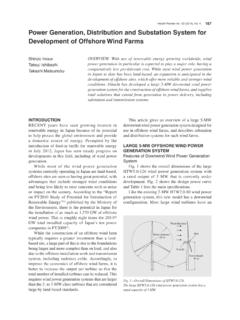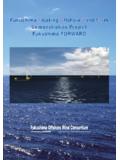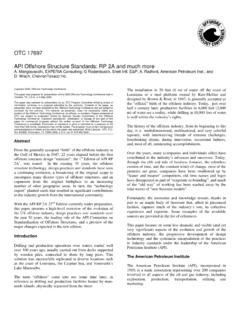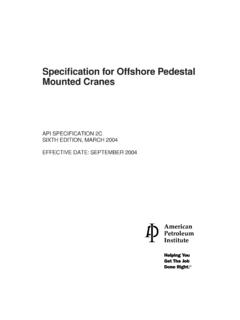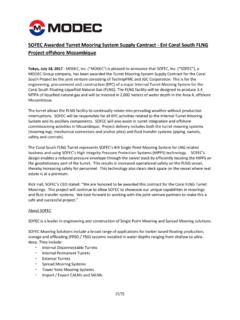Transcription of Seaworthy Hull Design - ShannonYachts
1 The Real Issues for offshore and Extended Sailing This section is devoted to the discussion of offshore issues that have been developed by Shannon as a basis of our current Design of blue water yachts. The formulation of our thoughts is based on our experience with tracking Shannon owners as they have sailed the oceans of the world in Shannon yachts for thirty one years. Calls and letters from our loyal and dedicated owners from distant ports have continued to provide us with feedback that is so important to the evolution of our yachts. Comfort and speed underway, a safe vessel, and a rested crew, make for an exciting and safe passage. We welcome you to peruse this section and call us for more information about Shannon blue water yachts Seaworthy hull Design An offshore hull must be designed for both speed and a comfortable motion. The forward sections of the hull beneath the waterline must be "vee'd" with a fine entry to avoid pounding in a seaway.
2 Flat forward sections, influenced by inshore rating rules, punish and fatigue the crew during extended passages. The mid sections must be full enough to allow the placement of tanks near the centerline and below the waterline. Tanks placed in the ends of a boat affect the trim as fluids are consumed and weights change. The aft sections must have enough buoyancy to overcome the constantly changing weights of crew in the cockpit and gear in the lockers. The hull Design must be able to accommodate the necessary weight that is required for tankage, gear, equipment, machinery, etc. In the 21st century it is not difficult to Design a light racing boat that will go fast, but an offshore cruising yacht must be able to carry the necessary tonnage and still provide fast passages on all points of sail and in all wind speeds. The keel must be strong enough to go aground without undue concern about unseen, collateral damage from keel bolt sheering. The base of the keel should be flat and parallel with the waterline so the boat will stand on its bottom to "dry out" against a pier.
3 The rudder should be mounted on a rugged skeg for protection. The propeller should be mounted in an aperture to avoid having an exposed propeller and shaft. A bent propeller blade can be field-repaired if necessary, but a badly bent propeller shaft requires hauling the boat and professional help and machinery is not readily available in many parts of the world. Finally, the hull Design must incorporate low center of gravity along with form stiffness to be able to carry sail in heavy weather. Safe Deck Design Deck designs that are influenced by round the buoy racing are both tiring and dangerous. The ability to get around the side decks easily on a moving boat in the dark is absolutely critical. Genoa tracks, blocks and shrouds placed in the middle of the side decks have no place on an offshore cruising boat. The perceived reason for placing sheeting tracks and inboard shrouds on a sailboat down a deck is to obtain a better "sheeting angle" for windward sailing.
4 While it is true that a close sheeting angle coupled with a violin tight headstay will allow a sailboat to point a few degrees higher in a racing situation, the advantage is mostly lost when a boat has a roller furling headsail installed. It is impossible to obtain the necessary luff tension on any roller furling gear to warrant the dangerous negatives of cluttering the side decks. Shannons point as high as boats with inboard shrouds and sheeting if the other boat has roller furling. Inboard sheeting (with roller furling) has a great deal to do with "fashion" and very little to do with performance. The deck Design should also incorporate toe rails that are not too high to trap whitewater coming over the deck. High bulwarks can retain tons of seawater that creates a dangerous situation as it slowly drains. The trunk sides of the cabin should not slope too much for style sake as this creates a slippery place to lose footing. A flush deck with no raised trunk cabin provides very little sea protection to those in the cockpit.
5 The companionway should be placed close to the centerline and away from the side of the hull . There should be a clear, continuous run from the cockpit to the bow for jacklines, so the crew can use safety harness without unhooking. Shannons have full length, useable handrails on the trunk cabin top and all lifeline stanchions and pulpits are 30" high The Cockpit The cockpit Design is the most critical aspect of a sailboat. Without a doubt the safety and comfort of the crew is a key element in the ability of a sailing yacht to go long distances. Fatigue is the major factor in accidents and navigational errors aboard boats. Experienced cruisers know that 90% of daylight hours in the tropics are spent in the cockpit. Therefore, the ability to sit, lean, lay and stand comfortably must be designed into a cockpit. The seats must have seatbacks high enough to support a person's back in a normal sitting position. The distance between the cockpit seats must be less than 30" so a person can brace themselves easily with their legs when the boat heels.
6 The "Tee" shaped cockpits on the Shannon 43 and 47 have raised wings on the aft side of the fore and aft seats that provides another transverse seat back to sit and lounge while facing forward. The cockpit sole at the helm is angled to create a level place when the boat is heeling. The helm seat is curved to prevent slipping when heeled. The entire cockpit on Shannon's is surrounded by strong, high coamings to protect the crew from boarding seas. There are no walk-throughs in the cockpit or transom to compromise the integrity and safety of the boat and crew. Opening up the aft end of a cockpit for a walk-through to the transom for swimming is fine for a yacht sailed in sheltered waters, but the potential danger to the crew in offshore sailing from following seas is considerable. The cockpit designs on all Shannons incorporate a method of launching an emergency life raft without having to leave the safety of the cockpit. Shade from the harmful effects of UV have to be a priority for any cockpit Design .
7 There are several bimini designs for owners to choose from. Finally, there must numerous scuppers to safely drain the cockpit. Single Handed Sail Plan The most important issue for long distance sailing is that one person must be able to sail the boat without assistance in all wind and sea conditions. A husband/wife sailing team on a long passage means one person is below resting or cooking while the other person is above deck sailing. An offshore boat's rig must accommodate sail changing, reefing and tacking by one person without jeopardizing safety. Dependence on an autopilot for sail management can be dangerous if the unit fails, especially when the person on watch is out of the cockpit on deck. At Shannon, Walt Schulz has been dealing with the real issues of short handed sailing in boats over 38 feet since 1975 . No company in the marine industry has more experience than Shannon in setting boats up for husband/wife sailing teams to go long distances confidently without additional crew.
8 The Shannon Scutter and Sketch rigs were developed by Walt 1995 as an evolutionary milestone in his quest to perfect short-handed sailing. The Scutter rig became a reality because of the recent improvement in the dependability of roller furling gear. Be aware that in spite of all the hype and the claims, a large (135%-150%) genoa cannot be reefed down to make a safe working jib. A genoa can only be successfully reefed by 30% before the sail loses shape and becomes worthless with no drive into the wind. A conventional sloop with a roller furled genoa on a single headstay cannot be reefed down to create a working jib that can claw off a lee shore or beat into strong headwinds for long periods of time. A small spitfire jib hanked on a babystay added to the foredeck of a sloop is fine as a storm survival sail, but it is too small and too far aft for sailing into the wind. A staysail on a cutter rig has the same limitations. On the Shannon Scutter and Sketch a real working jib is placed on the bowsprit forward of the genoa.
9 By placing the jib forward, helm is reduced and the high cut jib will easily tack through the slot in front of the genoa. A Shannon is sailed normally with the genoa up to winds of about 20 knots. When the wind increases, the genoa is reefed ( a 130% genoa becomes approximately a 100% genoa.) As the wind climbs the reefed genoa is completely furled, and the working jib is rolled out. If necessary in true storm conditions, the working jib can also be reefed by 30% to become an effective heavy weather jib. In addition, Shannons are equipped with a removable storm jib inner forestay for extreme conditions. The Shannon Scutter and Sketch rigs create four useable headsail combinations all available without leaving the cockpit. Another feature of the new Scutter and Sketch rigs is the control of main halyard and reef lines from the cockpit. Thus, all sails, headsails and mainsail can be set, reefed and furled by one person from the cockpit. Our video on the Shannon Pilot 43 shows the ease in which sails can be raised and lowered by one person all from the cockpit.
10 For those looking for the ultimate in short-handed rigs, Shannon is one of the few builders that has real world experience designing and building two masted ketch/Sketch rigs. There are more Shannon ketches sailing the oceans of the world than other two mast rigs from any company in business today. Bullet-Proof Construction Unlike automobile and house construction, there are no government mandated minimum building standards for yacht construction. Even the voluntary standards that are used by some builders in the US and in Europe are intended for the low-end mass production yachts. Shannon's construction techniques and building materials have set the benchmark for quality offshore yachts. Shannon has been building composite linear PVC foam cored one piece hulls since 1981. In the test tank of the oceans of the world, Shannons have been up on reefs, rocks, breakwaters, coral heads and even picked up and dropped off a pier by Hurricane Andrew without holing the hull to prove the strength and integrity of our construction methods.
